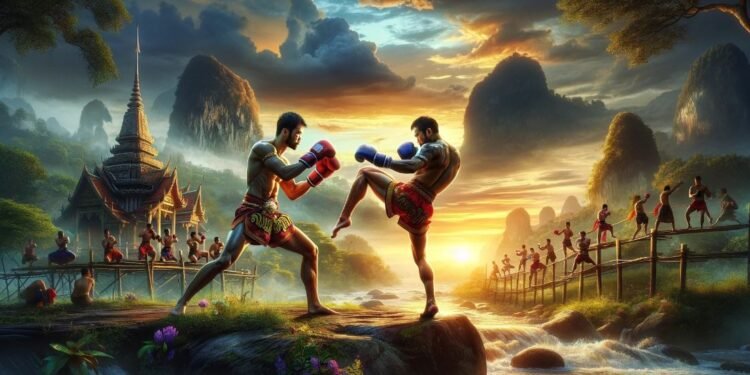Muay Thai, often called “The Art of Eight Limbs,” is a striking martial art and combat sport that originated in Thailand. This comprehensive guide delves into the rich history, fundamental techniques, training methods, and modern adaptations of Muay Thai. It is an informative resource for enthusiasts, practitioners, and those curious about this revered martial art.
The Historical Roots of Muay Thai
Muay Thai’s origins trace back several centuries in Thailand, where it evolved from various forms of traditional combat training. Initially developed for military purposes, it gradually became a sport intertwined with Thai culture and heritage.
Early Beginnings
The earliest forms of Muay Thai can be traced to the Sukhothai Kingdom in the 13th century. Warriors trained in hand-to-hand combat to defend their land, using their entire body as a weapon. This fighting style was essential for soldiers, as battles were often hand-to-hand.
Evolution into a Sport
By the 16th century, Muay Thai transitioned from military training to a form of entertainment. Fighters began competing in front of spectators, and it became a part of local festivals and celebrations. The sport’s popularity soared, and it became a symbol of national pride and cultural identity in Thailand.
Muay Thai Techniques and Fundamentals
Muay Thai is distinguished by its use of the entire body as a weapon. This section explores the fundamental techniques that define this martial art.
Striking Techniques
Muay Thai fighters utilize a combination of punches, elbows, knees, and kicks. The sport’s unique aspect is the simultaneous use of these techniques, earning it the name “The Art of Eight Limbs.” Each limb plays a crucial role in both offense and defense.
- Punches: Like Western boxing, Muay Thai includes jabs, hooks, and uppercuts. These punches are often used to set up more powerful strikes.
- Elbows: Elbow strikes are lethal and can cause significant damage. They are often used in close-range combat.
- Knees: Knee strikes are a hallmark of Muay Thai, used both in the clinch and from a distance. They can generate tremendous force and are effective against various targets on the opponent’s body.
- Kicks: Muay Thai kicks are renowned for their power. The roundhouse kick, in particular, is a staple technique, delivered with the shin rather than the foot for added impact.
The Clinch
The clinch is a grappling aspect of Muay Thai, where fighters seek to control their opponent’s head and body in close quarters. It’s a strategic position for executing knee strikes and setting up throws or sweeps.
Training and Conditioning in Muay Thai
Training for Muay Thai is rigorous and demands both physical and mental discipline. This section outlines typical training routines and conditioning methods Muay Thai practitioners use.
Typical Training Regimen
A Muay Thai training session often includes various components:
- Warm-Up and Conditioning: Running, skipping rope, and calisthenics to build stamina and flexibility.
- Technical Drills: Practicing punches, kicks, elbows, and knees on pads or heavy bags.
- Pad Work: Working with a trainer on focus mitts or Thai pads to develop accuracy, power, and combinations.
- Clinch Work: Practicing the art of clinching, including positioning, control, and executing knee strikes.
- Sparring: Controlled fighting with a partner to apply techniques in a realistic setting, emphasizing approach over power.
Physical and Mental Conditioning
Muay Thai fighters undergo intense physical conditioning to build strength, endurance, and resilience. Equally important is mental activity, which involves developing focus, discipline, and the ability to remain calm under pressure.
Modern Muay Thai and Its Global Influence
In recent decades, Muay Thai has gained immense popularity worldwide. Its influence is evident in various aspects of martial arts and combat sports.
Muay Thai in Mixed Martial Arts (MMA)
Muay Thai techniques have become a fundamental part of MMA training. Many MMA fighters incorporate Muay Thai striking and clinching techniques into their repertoire, appreciating their effectiveness in the cage.
The Sport’s Global Reach
Muay Thai has spread beyond Thailand, with gyms and training camps established worldwide. International competitions have also become common, showcasing the sport’s growing appeal.
Cultural Impact
As Muay Thai has globalized, it has influenced fitness trends and martial arts culture worldwide. Its emphasis on discipline, respect, and hard work resonates with practitioners from diverse backgrounds.
Conclusion
Muay Thai is more than a combat sport; it’s a rich cultural tradition, a demanding physical discipline, and a rapidly growing international phenomenon. Its blend of history, technique, and rigorous training continues to attract practitioners worldwide, making it a martial art with both deep roots and a vibrant, evolving future.
This exploration into Muay Thai provides insight into its origins, techniques, training, and global impact. Whether you’re a seasoned fighter, a martial arts enthusiast, or simply curious about this dynamic sport, Muay Thai offers a fascinating and rewarding journey.
Also, Read Play It Again Sports-Where Quality Meets Eco-Friendliness.




